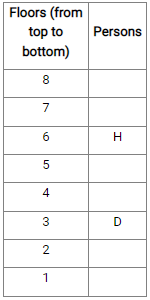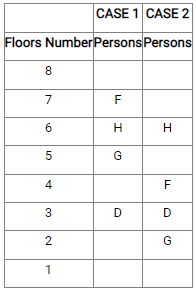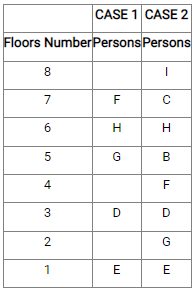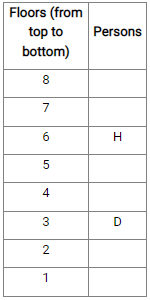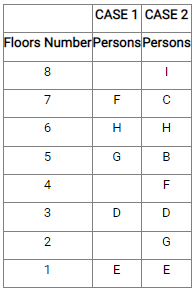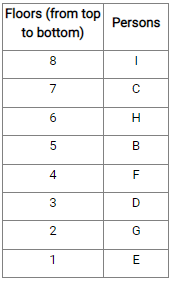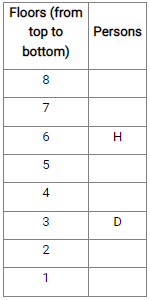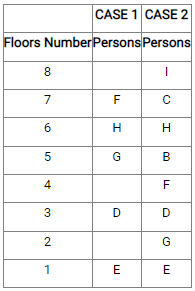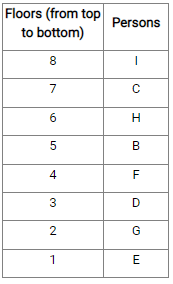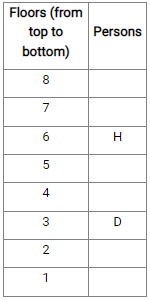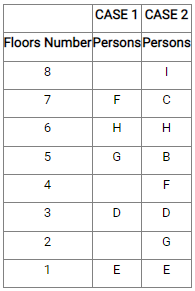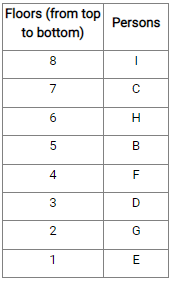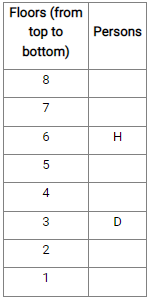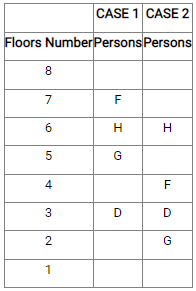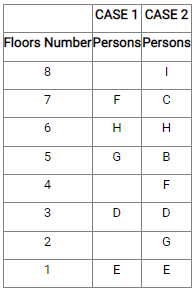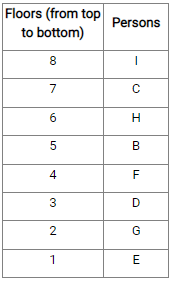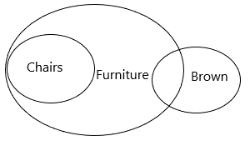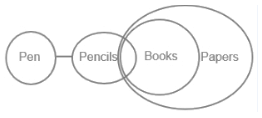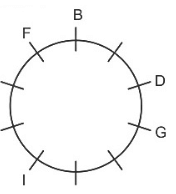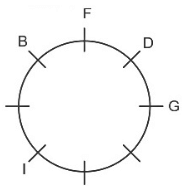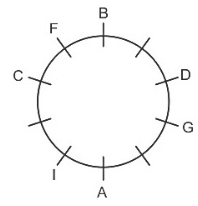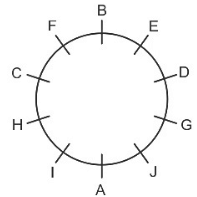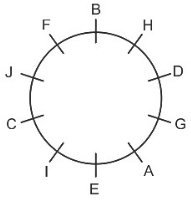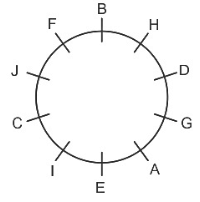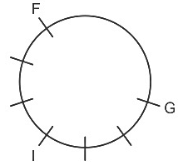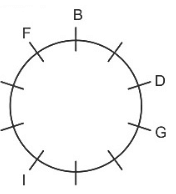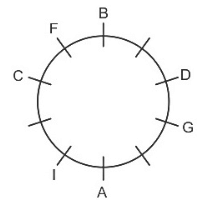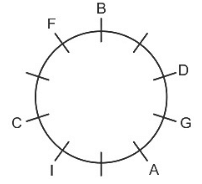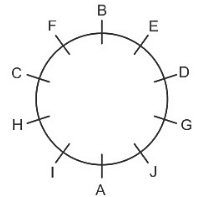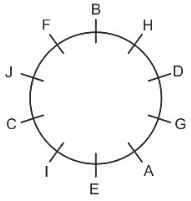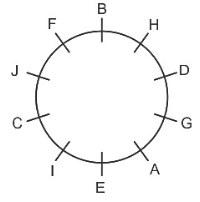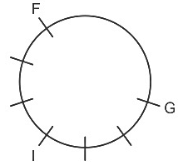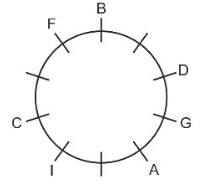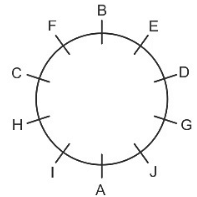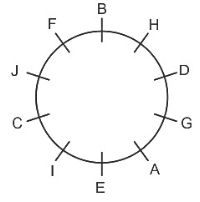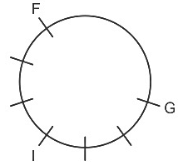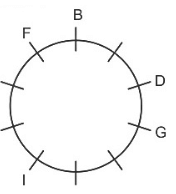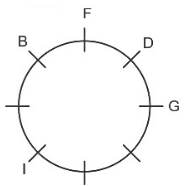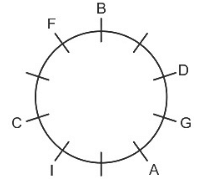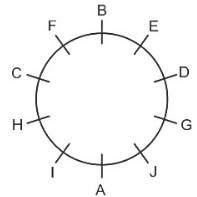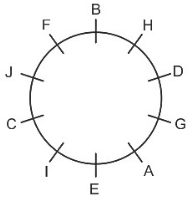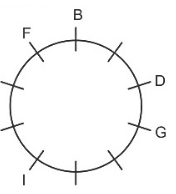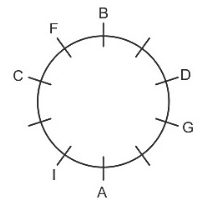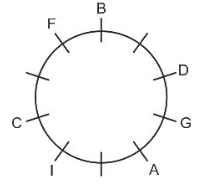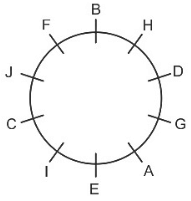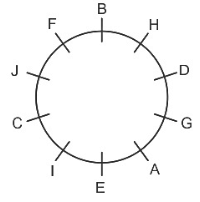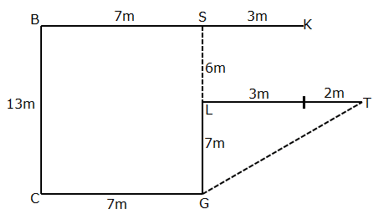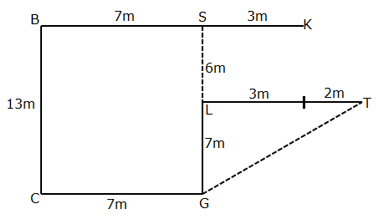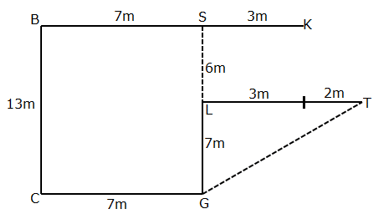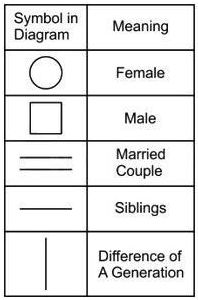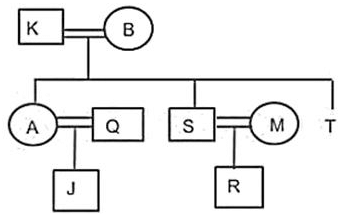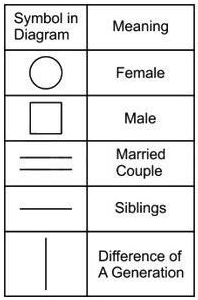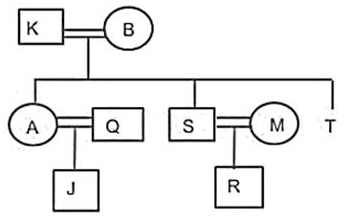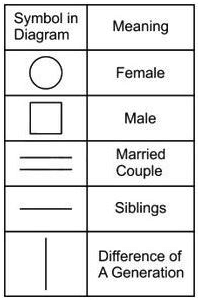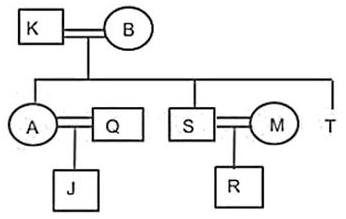IBPS RRB Clerk Prelims Mock Test - 2 - Bank Exams MCQ
30 Questions MCQ Test - IBPS RRB Clerk Prelims Mock Test - 2
Direction: Study the information carefully and answer the given questions.
There are eight people B, C, D, E, F, G, H and I are living in a eight storey building, but not necessarily in the same order. The ground floor is numbered 1 and the floor above it is numbered 2, and so on, until the topmost floor is numbered 8. D lives on the third numbered floor. Only two persons live between the floors of D and H. Only one person lives between the floors of D and E while E lives below the floor of F. I lives on the floor immediately above the floor on which C lives. F lives above G. Only one person lives between the floors of F and G.
Q. Who lives on 7th floor?
Direction: Study the information carefully and answer the given questions.
There are eight people B, C, D, E, F, G, H and I are living in a eight storey building, but not necessarily in the same order. The ground floor is numbered 1 and the floor above it is numbered 2, and so on, until the topmost floor is numbered 8. D lives on the third numbered floor. Only two persons live between the floors of D and H. Only one person lives between the floors of D and E while E lives below the floor of F. I lives on the floor immediately above the floor on which C lives. F lives above G. Only one person lives between the floors of F and G.
Q. Which of the following statements is correct?
Direction: Study the information carefully and answer the given questions.
There are eight people B, C, D, E, F, G, H and I are living in a eight storey building, but not necessarily in the same order. The ground floor is numbered 1 and the floor above it is numbered 2, and so on, until the topmost floor is numbered 8. D lives on the third numbered floor. Only two persons live between the floors of D and H. Only one person lives between the floors of D and E while E lives below the floor of F. I lives on the floor immediately above the floor on which C lives. F lives above G. Only one person lives between the floors of F and G.
Q. How many people live between D and I?
Direction: Study the information carefully and answer the given questions.
There are eight people B, C, D, E, F, G, H and I are living in a eight storey building, but not necessarily in the same order. The ground floor is numbered 1 and the floor above it is numbered 2, and so on, until the topmost floor is numbered 8. D lives on the third numbered floor. Only two persons live between the floors of D and H. Only one person lives between the floors of D and E while E lives below the floor of F. I lives on the floor immediately above the floor on which C lives. F lives above G. Only one person lives between the floors of F and G.
Q. Four of the following five options are alike in a certain way, find out the odd one?
Direction: Study the information carefully and answer the given questions.
There are eight people B, C, D, E, F, G, H and I are living in a eight storey building, but not necessarily in the same order. The ground floor is numbered 1 and the floor above it is numbered 2, and so on, until the topmost floor is numbered 8. D lives on the third numbered floor. Only two persons live between the floors of D and H. Only one person lives between the floors of D and E while E lives below the floor of F. I lives on the floor immediately above the floor on which C lives. F lives above G. Only one person lives between the floors of F and G.
Q. Who lives immediate above F?
In each of the following questions, the relationship between different elements is shown in the statements followed by two conclusions. Find the conclusion which is definitely true.
Given answers:
a) Only Conclusion I is true
b) Only Conclusion II is true
c) Both Conclusions I and II are true
d) Either Conclusion I or II is true
e) Neither Conclusion I nor II is true
Q. Statements:
S > G ≥ R =T ≤ Q; Y = J ≥ G > L
Conclusions:
I). R < Y
II). L < Q
In each of the following questions, the relationship between different elements is shown in the statements followed by two conclusions. Find the conclusion which is definitely true.
Given answers:
a) Only Conclusion I is true
b) Only Conclusion II is true
c) Both Conclusions I and II are true
d) Either Conclusion I or II is true
e) Neither Conclusion I nor II is true
Q. Statements:
E < L ≥ H = C; H < X < P
Conclusions:
I). X < C
II). C < X
In each of the following questions, the relationship between different elements is shown in the statements followed by two conclusions. Find the conclusion which is definitely true.
Given answers:
a) Only Conclusion I is true
b) Only Conclusion II is true
c) Both Conclusions I and II are true
d) Either Conclusion I or II is true
e) Neither Conclusion I nor II is true
Q. Statements:
D ≥ H =I > R; H > J ≥ W < O
Conclusions:
I). O > I
II). W < D
In each of the following questions, the relationship between different elements is shown in the statements followed by two conclusions. Find the conclusion which is definitely true.
Given answers:
a) Only Conclusion I is true
b) Only Conclusion II is true
c) Both Conclusions I and II are true
d) Either Conclusion I or II is true
e) Neither Conclusion I nor II is true
Q. Statements:
F > U ≤ R = C; R ≤ X < P ≤ T
Conclusions:
I). T > C
II). U ≤ P
If 2 is subtracted from each even digit of the number “765435821” and 1 is added to each odd digit of the number, then how many digits are repeated more than once in the newly obtained number?
Direction: In the question below are given some statements followed by two conclusions numbered I and II. You have to take the given statements to be true even if they seem to be at variance with commonly known facts. Read all the conclusions and then decide which of the given conclusions logically follows from the given statements disregarding commonly known facts.
Statements:
Some bikes are cars.
All cycles are cars.
Conclusions:
I. Some bikes are cycles.
II. All cycles being bikes is a possibility.
Direction: In the question below are given some statements followed by two conclusions numbered I and II. You have to take the given statements to be true even if they seem to be at variance with commonly known facts. Read all the conclusions and then decide which of the given conclusions logically follows from the given statements disregarding commonly known facts.
Statements:
Some nuts are cashew.
All pista are almonds.
Some almonds are cashew.
Conclusions:
I: Some pista can be cashew.
II: Some nuts are almonds.
Direction: In the question below are given some statements followed by two conclusions numbered I and II. You have to take the given statements to be true even if they seem to be at variance with commonly known facts. Read all the conclusions and then decide which of the given conclusions logically follows from the given statements disregarding commonly known facts.
Statements:
All chairs are furniture.
Some furniture is brown.
Conclusions:
I. All furniture are chairs.
II. Some brown are furniture.
Direction: In the question below are given some statements followed by two conclusions numbered I and II. You have to take the given statements to be true even if they seem to be at variance with commonly known facts. Read all the conclusions and then decide which of the given conclusions logically follows from the given statements disregarding commonly known facts.
Statements:
No pen is a pencil.
Some pencils are books.
All books are paper.
Conclusions:
I. Some papers are pens.
II. All books are pens.
In the given number “687143592”, what is the sum of the cube value of the digits which are fifth from the left end and fourth from the right end?
Direction: Study the following information carefully to answer the given questions:
V @ 2 3 K 6 # P % S 1 7 & * G I ©️ 5 9 8 $ Y D A € 4 ¥ Z B O
If all the numbers in the above arrangement are dropped, then which of the following will be the thirteenth from the left end?
Direction: Study the following information carefully to answer the given questions:
V @ 2 3 K 6 # P % S 1 7 & * G I ©️ 5 9 8 $ Y D A € 4 ¥ Z B O
Which of the following is the seventh to the left of the sixteenth element from the right end of the above arrangement?
Direction: Study the following information carefully to answer the given questions:
V @ 2 3 K 6 # P % S 1 7 & * G I ©️ 5 9 8 $ Y D A € 4 ¥ Z B O
Four of the following five are alike in a certain way based on their positions in the above arrangement and so form a group. Which is the one that does not belong to that group?
Direction: Study the following information carefully to answer the given questions:
V @ 2 3 K 6 # P % S 1 7 & * G I ©️ 5 9 8 $ Y D A € 4 ¥ Z B O
Four of the following five are alike in a certain way based on their positions in the above arrangement and so form a group. Which is the one that does not belong to that group?
Direction: Study the following information carefully and answer the following questions:
Certain numbers of persons are sitting in a circular way and all are facing inside. G sits third to the right of I. Only two persons are sitting between I and F. B, who is one of the neighbours of F, sits second to the right of D. C sits third to the left of A and none of them is the neighbor of B. D sits immediate right of G. Only two persons sit between J and H. E sits third to the right of J. G is not a neighbor of J.
Q. Who sits third to the left of B?
Direction: Study the following information carefully and answer the following questions:
Certain numbers of persons are sitting in a circular way and all are facing inside. G sits third to the right of I. Only two persons are sitting between I and F. B, who is one of the neighbours of F, sits second to the right of D. C sits third to the left of A and none of them is the neighbor of B. D sits immediate right of G. Only two persons sit between J and H. E sits third to the right of J. G is not a neighbor of J.
Q. On arranging the alphabets as they appear in English alphabetical order in anticlockwise direction starting from A, how many persons do not change their position (except A)?
Direction: Study the following information carefully and answer the following questions:
Certain numbers of persons are sitting in a circular way and all are facing inside. G sits third to the right of I. Only two persons are sitting between I and F. B, who is one of the neighbours of F, sits second to the right of D. C sits third to the left of A and none of them is the neighbor of B. D sits immediate right of G. Only two persons sit between J and H. E sits third to the right of J. G is not a neighbor of J.
Q. How many persons sit between J and D when counted from the right of D?
Direction: Study the following information carefully and answer the following questions:
Certain numbers of persons are sitting in a circular way and all are facing inside. G sits third to the right of I. Only two persons are sitting between I and F. B, who is one of the neighbours of F, sits second to the right of D. C sits third to the left of A and none of them is the neighbor of B. D sits immediate right of G. Only two persons sit between J and H. E sits third to the right of J. G is not a neighbor of J.
Q. Who among the following sits third to the left of sixth from the right of J?
Direction: Study the following information carefully and answer the following questions:
Certain numbers of persons are sitting in a circular way and all are facing inside. G sits third to the right of I. Only two persons are sitting between I and F. B, who is one of the neighbours of F, sits second to the right of D. C sits third to the left of A and none of them is the neighbor of B. D sits immediate right of G. Only two persons sit between J and H. E sits third to the right of J. G is not a neighbor of J.
Q. How many persons are sitting in the circular table?
Study the following information carefully and answer the questions given below.
Point K is 10m to the east of point B, which is 13m to the north of point C. Point G is 7m to the east of point C. Point L is 7m to the north of point G. Point L is 5m to the west of point T. Point S is 3m to the west of point K.
Q. Four of the following five are alike in a certain way as per the given arrangement and hence form a group. Find the one that doesn’t belong to that group.
Study the following information carefully and answer the questions given below.
Point K is 10m to the east of point B, which is 13m to the north of point C. Point G is 7m to the east of point C. Point L is 7m to the north of point G. Point L is 5m to the west of point T. Point S is 3m to the west of point K.
Q. What is the distance and direction of Point S with respect to point L?
Study the following information carefully and answer the questions given below.
Point K is 10m to the east of point B, which is 13m to the north of point C. Point G is 7m to the east of point C. Point L is 7m to the north of point G. Point L is 5m to the west of point T. Point S is 3m to the west of point K.
Q. What is the shortest distance between Points G and T?
Direction: Study the following information to answer these questions.
A is the sister of S and T. J is the only son of the brother-in-law of S. S is married to M. S is son of K. K and B has three child. A is married to Q. R is son of S.T is unmarried. B is the grandmother of R.
Q. How is B related to M?
Direction: Study the following information to answer these questions.
A is the sister of S and T. J is the only son of the brother-in-law of S. S is married to M. S is son of K. K and B has three child. A is married to Q. R is son of S.T is unmarried. B is the grandmother of R.
Q. How R and J are related to each other?
Direction: Study the following information to answer these questions.
A is the sister of S and T. J is the only son of the brother-in-law of S. S is married to M. S is son of K. K and B has three child. A is married to Q. R is son of S.T is unmarried. B is the grandmother of R.
Q. How is T related to J?


